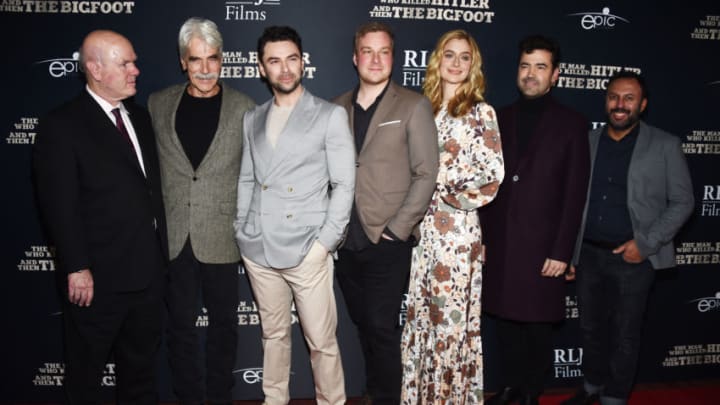Where The Man Who Killed Hitler and Then the Bigfoot went wrong

The Man Who Killed Hitler and Then the Bigfoot review
When The Man Who Killed Hitler and Then the Bigfoot came out in 2018, it generated buzz galore, but also conflicting reviews. The only consistent acclaim was for Sam Elliott’s performance, which was said to be outstanding, and rightfully so.
I never got to see the movie when it was released. That’s why I was excited to find The Man Who Killed Hitler and Then the Bigfoot in the “Movies For You” suggestions on Hulu.
Yes, Hulu. Good job. Nailed it again. This is a movie I was interested in seeing. Thank you for letting me know you have it.
I started out loving it, especially Sam Elliott, who I never give enough credit to. It’s his own fault. NPR summed it up best in their review of the movie when they deemed him a “reliable screen presence.”
Yes. That’s what he is. I take it for granted that he’ll deliver, and then find myself surprised when he does. It’s probably something that comes as little surprise to fans of The Ranch who also saw his A Star Is Born Oscar-nominated performance. They know not to underestimate his value.
I did. I admit it. Hopefully, I’ll remember not to do that next time.
In the movie, Elliott plays Calvin Barr, an introspective, elderly man reflecting on his memories.
At first glance, he seems as unremarkable as he is humble. But as we’re privy to his flashbacks, we realize this quiet man is not ordinary. He’s led a remarkable life and has also known remarkable heartbreak.
The flashbacks aren’t linear, which is fine. One second, the younger Barr, played by Aidan Turner, is dressed as a Nazi SS leader delivering a package to the Furor. The next he’s working in a hat shop and meeting the girl who will become the love of his life, Maxine, played by Caitlin FitzGerald.
I really liked how the flashbacks were accomplished, though. They weren’t disjointed like some can be where you’re suddenly thrown into another scene and you don’t know if it’s now or before.
They were also artfully done, either using an object or a color to tie into whatever memory Barr was reliving.
And the love story is worthy of mentioning because it was sweet and unexpected. At least, I wasn’t expecting something like that from a movie with a title like The Man Who Killed Hitler and Then the Bigfoot.
However, there was also a bit of mystery and suspense.
Like in the beginning when Barr leaves the bar he’d been drinking at. Was there a car following him? It seemed like there was, but what happened to it?
Maybe it’s the thugs who attack him? No. They were on foot and trying to steal his car –much to their dismay. They picked on the wrong old man to rob. Don’t let his white hair fool you. Barr is no holds barred when it comes to fighting. In almost superhero-esque style, he polishes off the bad guys and leaves them for the cops to find.
Then he goes home and cries. There’s more to Barr than meets than eye. He’s a tender, troubled soul, who’s about to know more trouble.
But first, we find out how he killed Hitler, via a flashback, of course.
If the movie had been just about that and his laments over his lost love, it would’ve been great.
There are a couple of things that are never explained, like how did a small-town boy who enlisted in the military learn multiple languages? I kept hoping to see that explained in a flashback, but it wasn’t. The only explanation that’s given comes from Barr when he says, “They’re just words.”
Not that it really matters. Fine. He’s fluent in Russian and German and who knows what else. We don’t know, but in the haircut scene, the “barber,” who’s a Russian soldier, keys us in that the languages Barr doesn’t speak are fewer than the ones he does.
Then, there was a car following him, and the mystery about why is revealed.
It has to do with murders of hikers in the north that have been alluded to during the “present” moments of the movie. The government needs Barr’s service again. It’s not a serial killer on the loose, as the media is leading people to believe, but an actual Bigfoot. One that’s infected with a deadly virus that will wipe out civilization if he makes it past a certain boundary.
Why are they asking an old man for help? Barr’s record precedes him. In addition to being a linguist, he’s a master tracker, a sharpshooter and who knows what else. Basically, he’s mythic. Plus, it’s been determined he’s among those immune to the virus.
Because the movie up until this point had been very good, I go along with this new plot development. But as soon as the Bigfoot comes into play, the whole movie pivots into something else.
The “and Then the Bigfoot” feels a bit like an afterthought in the title and definitely feels like that in the movie. How many genres can you cram into one film? Can you get away with action, historical, romantic, drama, thriller, pulp and creature feature all in one?
Maybe. Quentin Tarantino has been known to pull off similar movies. And while this one does feel Tarantino-ish in a good way for two-thirds of the movie, it goes wrong with the Bigfoot part.
However, it made for a catchy, albeit long, title. Elliott’s performance is worth the watch if you’re a fan. But if you feel compelled to turn it off before the Bigfoot third of the movie, you really wouldn’t miss much and probably would feel just as satisfied.
50 best movies on Netflix right now. dark. Next